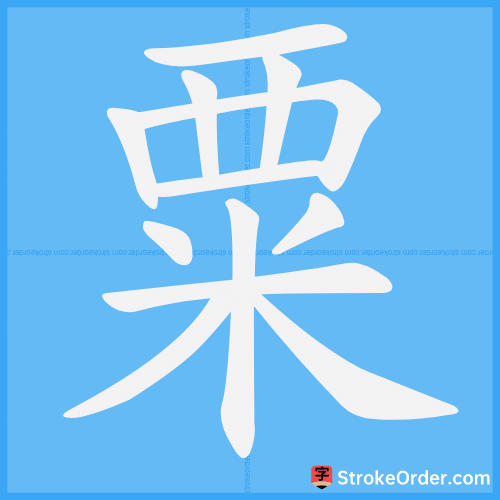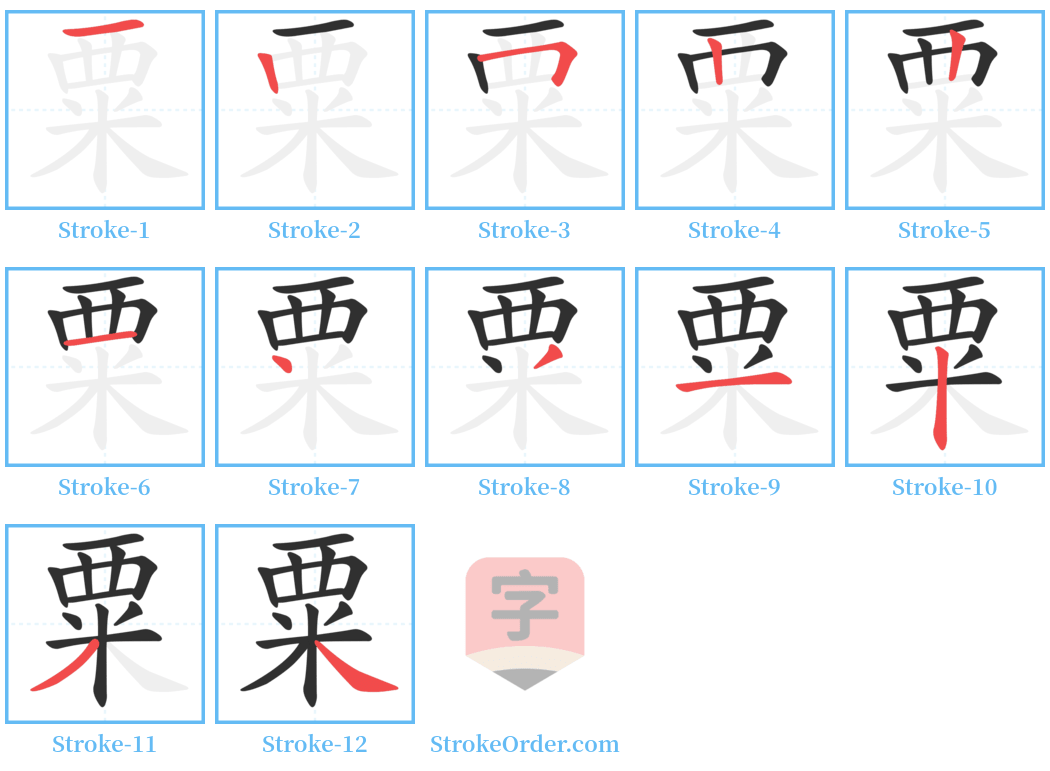粟 Stroke Order
Animated Stroke Order of 粟

Stroke Order Diagrams for 粟

Step-by-Step Handwriting Guide for 粟

Learn to Write Chinese Characters with Video Tutorials
Watch the video of writing the Chinese character "粟", learn the correct stroke order (笔顺) of the character "粟", and master the standard way of writing the character "粟".
Free Printable Handwriting Practice with Stroke Order: 粟
Printable Writing Practice Worksheet of "粟" in Portrait Orientation (Tian Zi Ge)

Printable Writing Practice Worksheet of "粟" in Landscape Orientation (Tian Zi Ge)

Information of 粟
Pinyin
sù
Radical
米
Strokes
12 strokes
Usage
★★★★★
Definition
grain / millet
粟 [sù]
1. A one-year herbaceous plant, its seeds are small and round or oval in shape. Commonly referred to as "millet" in the northern regions, and called "xiao mi" (little rice) after the husk is removed.
2. In ancient times, a general term for grains.
3. A surname.
粟 [sù]
1. A one-year herbaceous plant, its seeds are small and round or oval in shape. Commonly referred to as "millet" in the northern regions, and called "xiao mi" (little rice) after the husk is removed: 粟子 (sùzi). “Cang Hai Yi 粟” (a metaphor for smallness).
2. A general term for grains in ancient times: 重(zhòng)农贵粟 (emphasize agriculture, value grain).
3. A surname.
粟 [sù]
1. Same as the original meaning: foxtail millet; millet. In northern regions, commonly referred to as "millet," once husked called "little rice." A coarse, drought-resistant but frost-sensitive annual grass (Setaria italica) known for its thick, heavy, long spikes, used as grain, hay, and feed.
2. Grain. The unhulled ones are called 粟 (sù), the hulled are referred to as rice.
3. A general term for grains.
4. Things resembling small grains, metaphorically small (e.g., sand).
5. Small lumps, like goosebumps that appear on the skin due to cold.
6. Salary.
引
1. "说文" states: 粟, 嘉谷实也 (millet is a cherished grain).
2. "旧唐书·食货志下" records: "粟麦粳稻之属各依土地,贮之州县” (millet, wheat, rice, and other grains stored according to land in various states).
3. 清·邵长蘅 "阎典史传" mentions: "输不必金,出粟、菽、帛、布及它物者听” (it is not necessary to pay with gold, but can pay with grain, beans, silk, cloth, and other items).
例
如: 粟入 (revenue from grain taxes); 粟粒 (grain particles).
引
1. “明史·海瑞传”: 去淳安知县,布袍脱粟,令老仆艺蔬自给 (appointed as county magistrate, undressed, telling the old servant to grow vegetables for self-sufficiency).
2. 例: 粟饭 (brown rice).
引
1. "汉·贾谊·论积贮疏" states: "苟粟多而财有余,何为而不成?" (if grain is plentiful and wealth sufficient, what is there to worry about?).
2. "唐·韩愈·杂说": "马之千里者,一食或尽粟一石" (a horse that can travel a thousand miles may consume a stone of grain in one meal).
3. “李斯《谏逐客令》”: "臣闻地广者粟多,国大者人众” (I have heard that a wide area means more grain and a large country has more people).
例
如: 粟土 (soil suitable for growing grains); 粟红贯朽 (when grain is abundant and decays, money that hasn’t been used for a long time is also in disarray, metaphorically indicating a prosperous time).
引
如: 粟文 (patterns resembling grains); 粟金 (small grains of gold); 粟眉 (fine points of eyebrow makeup); 粟粒 (objects resembling grain); 粟错 (small errors similar to grains).
引
如: 粟栗 (goosebumps due to fear).
引
如: 粟秩 (salary, anciently paid with grain).
Input Method for 粟
Pinyin
su4
Wubi
sou
Cangjie
mwfd
Zhengma
fjuf
Four Corner
10904
Unicode
U+7c9f
Same Pronunciation Characters